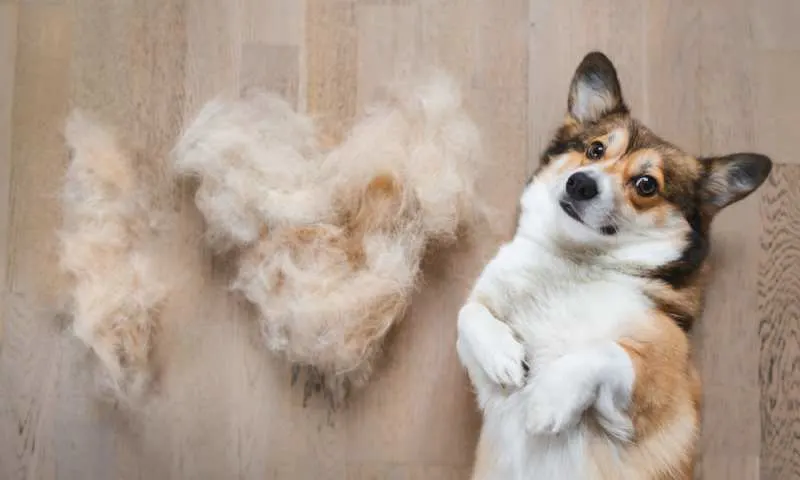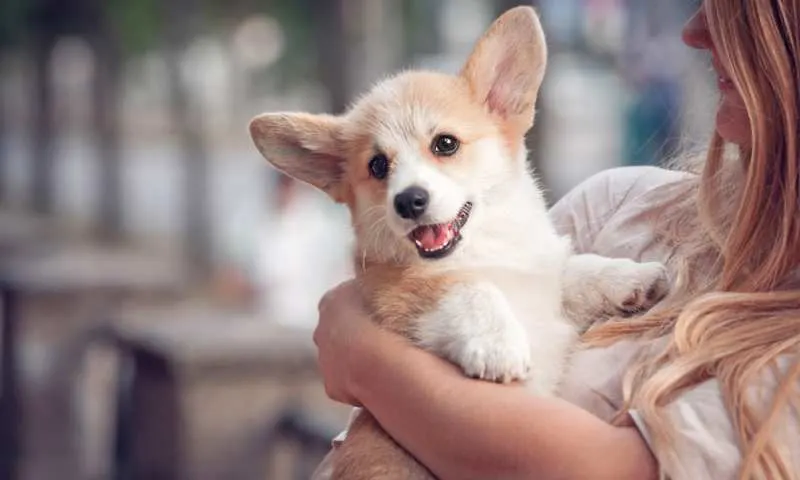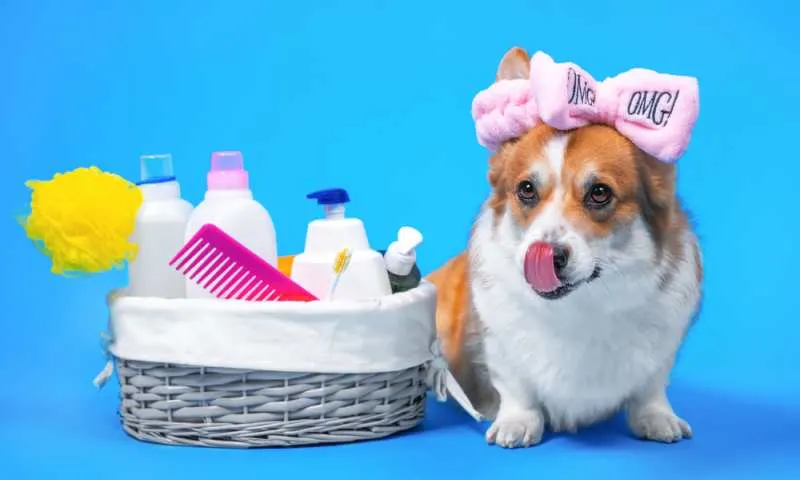There are many things for which Corgis are known as a breed. The short legs, the cute and happy demeanor, the seemingly royal heritage – the list goes on and on. But we can bet that when you hear the name Corgi, you think of something else. So the fashionable coat they have on has to be the first thing that pops to mind!
We admit it’s one of their best features. They are soft, huggable, and luscious. But, unfortunately, they also shed like crazy!
But if you have a Corgi puppy, you may be thinking that you got tricked by the cute fluffer! It’s not shedding at all as much as people are saying it would. Well, that’s because it still has its puppy coat on! So when does the real stuff start coming in? When do Corgis get their full coat?
Well, this varies from breed to breed. Usually, puppies get the full coat between the sixth and eighth months. This is the period in which those shedding rumors your Corgi came with will start confirming themselves.
But let’s try and explain why this happens – why is it that dogs need to grow out a whole new coat, and is there something wrong with the first one? Let’s get started.

When Do Corgis Lose Their Puppy Coats?
Well, we’ve mentioned that dogs generally lose their puppy coats between the sixth and eighth months. This is pretty much the timeframe for Corgis as well. Some dogs do it later, and it usually depends on what kind of coats they have.
Corgis, for instance, have very thick double coats. This means that they have two coats instead of one. This has to do with their origin and the region’s climate, but we’ll get back to that in a moment.
What are coats for exactly? Are they there just to keep the dog warm?
You see, dogs have a limited number of ways to control their body’s temperature. And when we say limited, we mean it!
You probably know how humans deal with temperature changes. If it gets hot, our body starts to sweat, and by getting rid of water through the sweat glands, our bodies get cooler. It sounds like a simple system, right? And it is, but, unfortunately, dogs can’t do that since they don’t have the glands necessary for the whole operation.
So how do they handle cold or hot temperatures? Well, they kind of don’t. If a dog is hot, it will try to go somewhere cooler. That’s why you’ll find your Corgi lying on the cold chicken tyles in the middle of summer or right next to you on the warm blanket during winter.
The shedding is actually the only way for them to regulate their body’s temperature! After the summer months, when the wind and rain start coming around, your Corgis body gets the signal to start growing out its winter coat.
This is because they were outside guarding herds for thousands of years on the windy hills of Wales. So their body knows how to get prepared for cold weather. And because Wales has all four seasons represented pretty darn equally – Corgis learned how to adapt their coats to anything!
The double coat is a part of those adapting capabilities. The undercoat keeps the body’s temperature at a comfortable number, while the outer coat protects it from wind and rain.
Likewise, during springtime, their coats start shedding off to prepare for the hotter temperatures. The isolation that the undercoat gives them works both ways. Sure, it keeps them warm during winter, but it also helps them maintain a lower body temperature during summer!
So what’s all this talk about a puppy coat them?
A “puppy coat” is a term for the first coat the dog is born with! But, unfortunately, these are usually much weaker and not yet ready for the harsh weather condition that Corgi coats can usually withhold.

What Is A Puppy Coat?
As we already mentioned, you probably figured out that a young Corgi puppy doesn’t shed nearly as much as their older counterparts. Why is that?
Well, the coat that your Corgi is born with hasn’t yet encountered the change in weather conditions that would tell the body that it’s time to adapt. The younger a puppy is, the more protected it is by humans or its parents.
But if the Corgi is born at the beginning of the summer, it will probably have to grow some more fur in six months to protect itself from the drop in temperature. This won’t be an overnight operation, but the body will try its best to adapt with the coat it has.
At this time, the body starts picking up clues from those three thousand years old genes and just gives up on the coat it has at the moment completely.
It sounds a bit strange when you think about it. But really, your Corgi will continue to do this during its whole life! It’s just that once the double coats roll in, the changes won’t seem so extreme. But we can assure you if you have a Corgi, the coats it has now are not the coats it had a year ago. They just keep shedding and regrowing.

Grooming During The Puppy Coat Faze
Okay, so we covered what a puppy coat is and when it falls off. But what about grooming the puppy coat? If it is not all that strong and plans on falling off anyways, does it need to be groomed as much as Corgis regular thick double coats?
Unfortunately, many people think that the grooming is there just so the dog would shed less. So let’s get something straight – that’s far from the truth!
Grooming is excellent for the health of your dog’s fur and its skin. By simply brushing your Corgi regularly, you are helping it get rid of hairs that have either already shed off or are planning on doing so. This stimulates the Corgis hair molecules to start growing out more fur.
And like we said, your Corgi is constantly shedding and regrowing fur, which means that it needs all the help it can get. Brushing your dog during the puppy coat period is as important as brushing during any period for multiple reasons.
First of all, your Corgi will get used to you brushing its hair regularly, and that’s a habit that you need your Corgi to know about. They shed like crazy when they develop their coats, and brushing them is pretty much the only thing you can do to help yourself and your furniture from getting covered in Corgi hair.
But even if we disregard that part, your Corgis coat and skin will be healthier if you brush it regularly. Just make sure to work through it with a delicate brush during the puppy coat period. You don’t want to risk damaging its still sensitive skin.
While on the subject, if you notice that your Corgis skin is flaky, red, or if your dog is itching and scratching like crazy – call your vet. Your Corgi could have developed an infection, which can be very dangerous at such a young age.
Your Corgi will, at one point or another, start shedding, and we can assure you, it will never stop. For this reason, it’s great for you to start getting used to brushing them daily. Sure, if your Corgi lives outside and rarely spends time indoors, you won’t notice this problem as much.
But Corgis are getting more and more popular by the year, and there are many of them living inside. So if we were to go by the statistics, you need to buy some brushes right away!
Just like your Corgi, you will also have to adapt to figure out how much your dog is shedding in cold and hot weather. This is so you can figure out when it’s happening too much. Excessive shedding usually indicates health problems, so you need to be on top of things at all times.

Final Words
So there we are. You learned all you needed to know about puppy coats and Corgis! Ofcourse, this doesn’t mean that you’re done learning new things, far from it! But, there is so much knowledge that can help you and your Corgi live together happier and healthier – why not learn as much as you can?
Corgis and their double coats take some getting used to; we know that better than everyone. But hey, what’s a bit of brushing now and then when compared to those little legs running towards you every time you get home?
Health is always a number one priority; it just so happened that the Corgis fashion and its health seem very connected. So get yourself a quality brush, and get prepared for some serious hair pulling!

